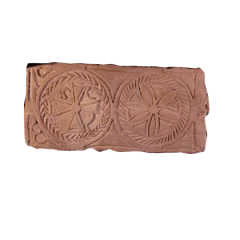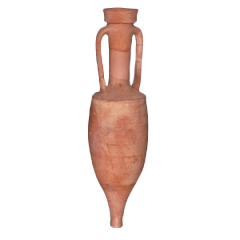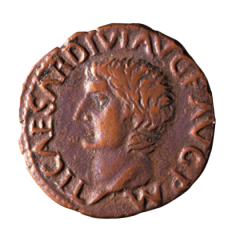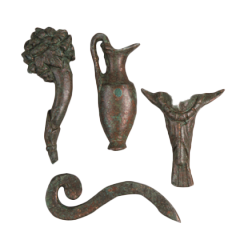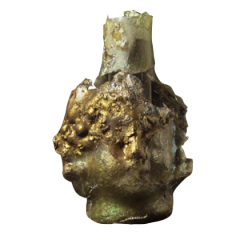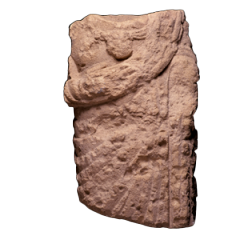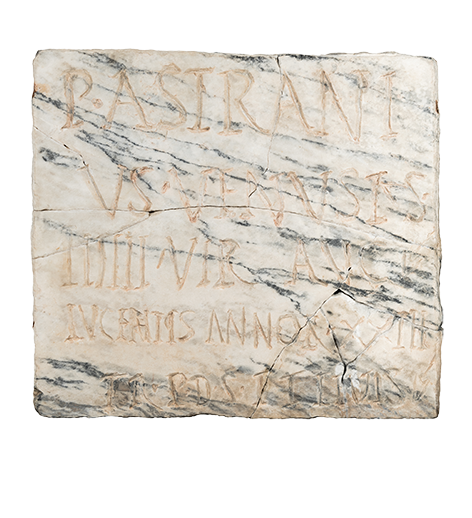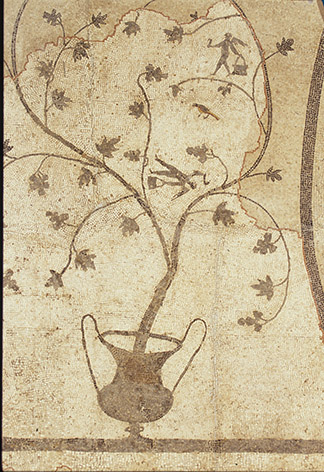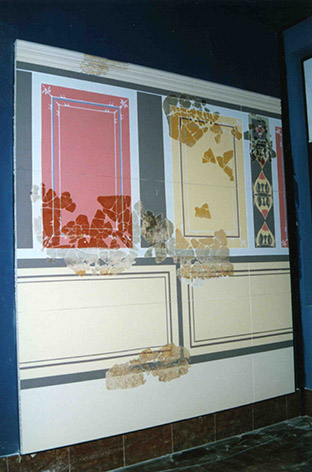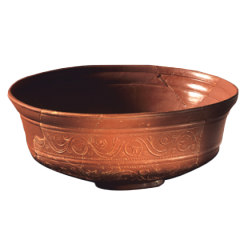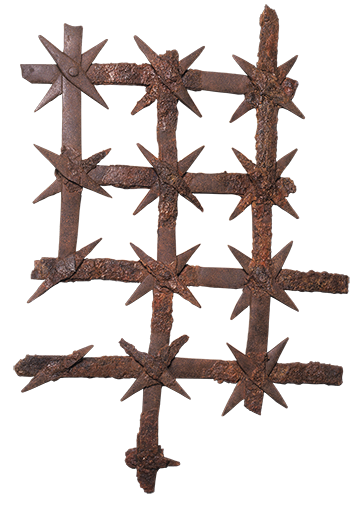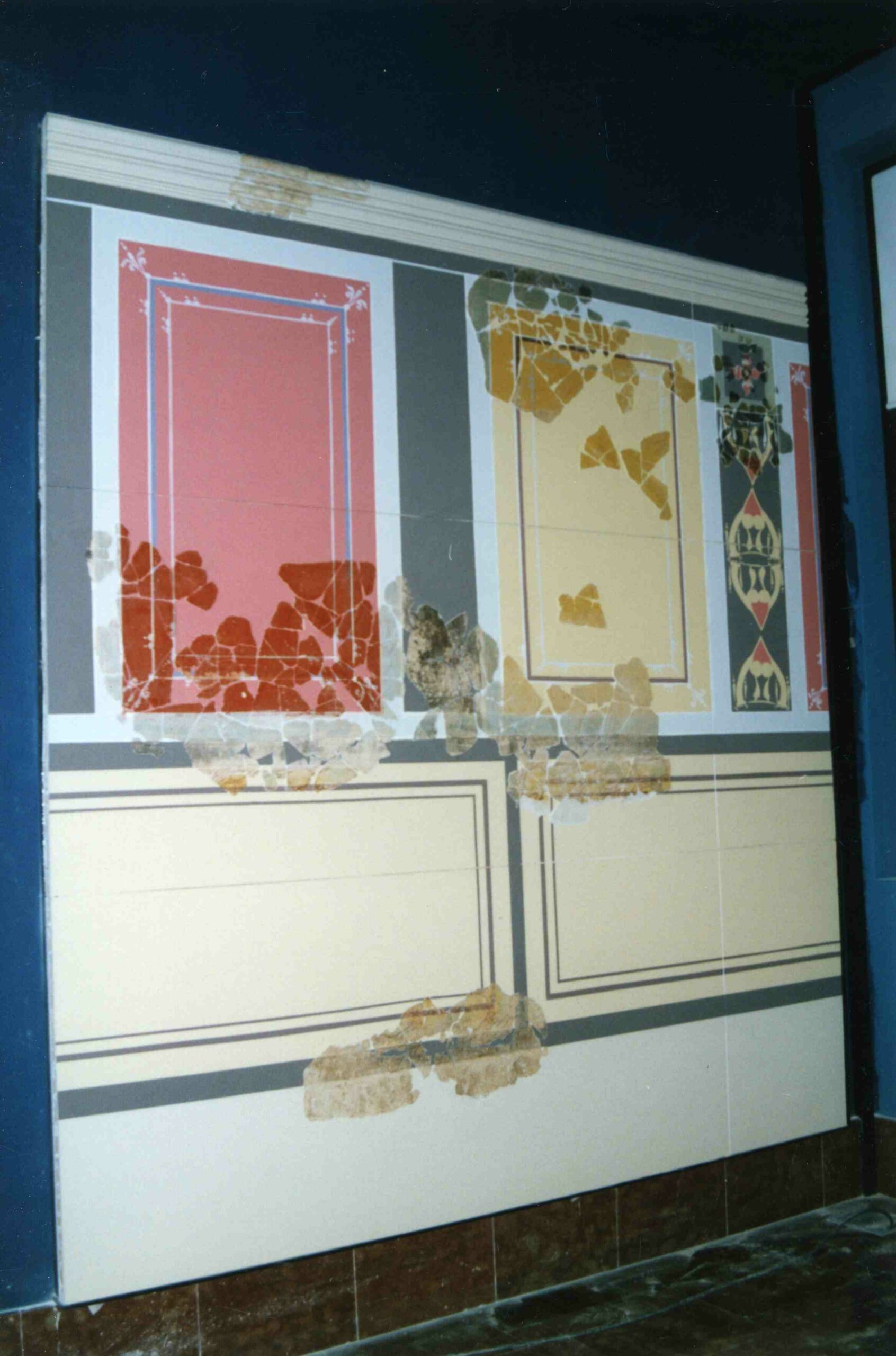
Mural painting of the domus of the eastern gate of Lucentum
Lucentum, Tossal de Manises (Alicante) Painting applied using the fresco technique on a lime mortar base. h: 305 cm; w: 265 cm h: 303 cm; w: 139 cm; d: 8 cm Roman culture First half of the 2nd century AD.
Reconstruction of the mural painting decoration of a room at Lucentum based on fragments recovered in the 1980s by M. Monraval.
The wall can be divided horizontally into three parts. If we start from the bottom upwards, we can see the following decoration: the lower part is made up of a 30 cm. If we start from the bottom upwards, we can see the following decoration: the lower part is made up of a beige-coloured, 30 cm high, continuous skirting board and a plinth divided into rectangular panels representing a double imitation marble, imitation Numidicum and Pavonazzetto marble framed by black bands and red fillets on the one hand, and imitation Cipollino marble on the other; in the middle area there is a succession of wide and narrow panels, the former using red, yellow and green spot colours, and the latter or interpanels, decorated with vegetal candelabra and crowned with a fleuron in a square; finally, the upper register is replaced by a moulded stucco cornice approximately 15 cm high. The upper register is replaced by a moulded stucco cornice about 15 cm high. While the first two parts of the wall stand out for their rich polychromy and for the fillets ending in vegetal motifs or for the dots in the angles or framing corners, the upper part and the ceiling, on the other hand, have a completely white background, which nevertheless highlights the different motifs that are constantly repeated within a decoration based on a grid system very common at the time in which it is framed. The latter consists of a series of medallions made up of vegetal garlands that in turn enclose other denticulated medallions with various figurative motifs inside them, such as birds, moon masks and different types of schematic flowers.
Roman painting is mainly mural painting, unlike Greek painting, and has a dual function: on the one hand, to cover a wall, often made of poor material, and on the other hand, to serve as an ornamental covering thanks to the decorative elements or motifs depicted on them. The paintings shown here meet both requirements: utilitas and ornamentation, and in terms of their decoration we can say that the commissioner who commissioned them adhered to the tastes and preferences of the period to which they belong. This can be clearly seen in the lower area, where the skirting board and plinth are an imitation of a type of marble covering that was very common in all the Roman provinces, but which perhaps due to its high cost was replaced by its imitation in paint; in the middle area with the typical decoration in the style of the candelabra that developed in the western provinces between the end of the 1st century and the beginning of the 2nd century AD, and on the ceiling with the system of netting that was so fashionable throughout the 2nd century AD.
S.C. 3364, 3770, 3775, 3776 and 3777
MONRAVAL SAPIÑA, J.M. 1992.
FERNÁNDEZ DÍAZ, A. 2000-2001.
Highlights Sala Cultura Romana
- ................................................. Cerro de Las Balsas (Albufereta, Alicante) Sandstone h: 97 cm; w: 46 cm; d: 12 cm h: 66 cm; w: 50 cm; d: 13 cm Roman culture 7th century AD: 46 cm; w: 12 cm h: 66 cm; h: 50 cm; w: 13 cm Roman culture 7th century AD.
- ................................................ Tossal de la Cala (Benidorm) Ceramic h:118 cm; w. 32 cm Roman culture Late 2nd - early 1st century BC: 32 cm Roman culture Late 2nd - early 1st century BC Typology Dressel 1, subtype B.
- ................................................. Isidro Albert Collection Bronze d: 2'12 cm; w: 4'7 g; d.w.:12 h Roman culture 22-23 A.D. 5th issue
- ................................................. Lucentum, Tossal de Manises (Alicante) Bronze Plate: h: 21'5 cm; w: 5'7 cm; d: 0'3 cm Bucranes: h: 7-7'7cm; w: 6'2 cm; d: 1-1'6 cm Urceus: h: 8'7 cm ; w : 3'9 cm; e: 0'8 cm Lituus: h: 10'5 cm; a: 3'5 cm; e: 0'4 cm Cornucopia: h: 9'1cm; a: 4 cm; e: 1'5 cm Roman culture 1st century AD.
- ................................................. Necropolis of El Albir (l'Alfaç del Pi) Glass h: 7'5 cm; w: 4'1 cm; d: 3'6 cm Roman culture 5th century AD: 4'1 cm; e: 3'6 cm Roman culture 5th century AD.
- ................................................. Lucentum, Tossal de Manises (Alicante) Sandstone h: 42 cm; w: 24.5 cm, d: 12 cm Roman culture Second half of the 1st century BC.
- ................................................. Lucentum (Tossal de Manises, Alicante)White marble with grey veinsh: 31.11cm; h: 28.4cm; w: 2cmRoman culture2nd century AD.
- ................................................. Baños de la Reina (Calpe, Alicante) Stone tesserae h: 264 cm; w: 288 cm Roman culture 2nd century AD.
- ................................................. Lucentum, Tossal de Manises (Alicante) Painting applied using the fresco technique on a lime mortar base. h: 305 cm; w: 265 cm h: 303 cm; w: 139 cm; d: 8 cm Roman culture First half of the 2nd century AD.
- ................................................. Lucentum (Tossal de Manises, Alicante) Ceramic h: 23.6 cm; w: 8.1 cm; d: 10.1 cm Roman culture Towards the first half of Nero's reign (50-60/65 BC).
- ................................................. Illeta dels Banyets (Alicante) Iron h: 72 cm; w: 49 cm; d: 3 cm Roman culture 2nd century AD: 49 cm; e: 3 cm Roman culture 2nd century AD.

